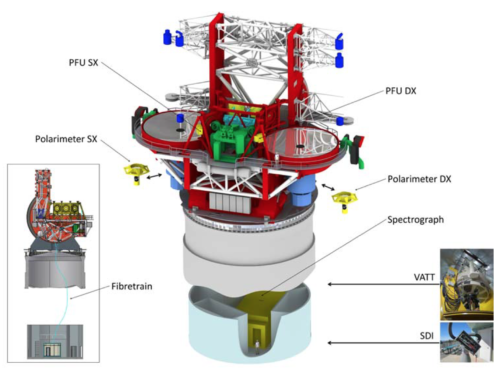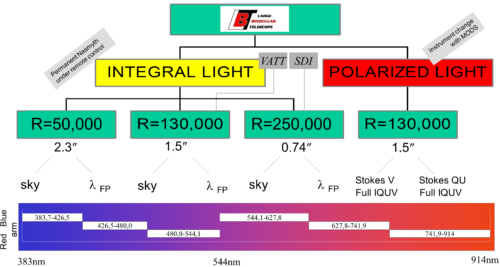PEPSI
PEPSI stands for the Potsdam Échelle Polarimetric and Spectroscopic Instrument and is the fiber-fed high-resolution optical échelle spectrograph for the Large Binocular Telescope (LBT). It is designed to utilize the two 8.4m apertures of the LBT in a seeing-limited mode so that light can be fed to the spectrograph via two permanently-mounted focal stations (PFUs), thereby providing a high-resolution standby spectrograph. Three spectral resolutions of either 50,000, 130,000 or 250,000 can cover the entire optical/red wavelength range from 3819 to 9064 Angstroms in three exposures.
On the CCDs, every single échelle order consists therefore of four independent spectra, two from the optical axis of each of the primaries, and two from their respective off-axis positions. While the on-axis light is always reserved for a “target,” the off-axis fibers simultaneously allow either sky light or wavelength calibration light.

PEPSI transitioned from a PI instrument to a facility instrument in 2020B and is now available for flexible scheduling within Partner blocks. If you wish to observe with PEPSI or have any questions, please contact our Science Operations team at sciops@lbto.org.
The PEPSI system design was driven by the binocular structure of the telescope and the wish to operate a polarimeter together with a permanently available fiber feed for integral light. The integral light feed mode of PEPSI, permanently mounted at the LBT, is available for regular use.
The integral-light spectroscopy mode covers the wavelength range of 3819–9064 Å with three choices of fiber sizes which affects the spectral resolution and on-sky aperture size. Note that the R=50,000 mode with its 12-pix sampling per resolution element is our “bad seeing” or “faint-object” mode.
| Fiber size (μm) | On-Sky Aperture Diameter (arcsec) | Spectral Resolution (R = λ/Δλ) |
| 100 | 0.74 | 250,000 |
| 200 | 1.50 | 130,000 |
| 300 | 2.30 | 50,000 |
PEPSI has two arms, blue and red, that cover spectral ranges 3819–5425 Å and 5361–9064 Å, respectively. The following table summarizes the wavelength coverage for each cross disperser as measured with the 100 micron fiber.
| Cross Disperser | Wavelength Coverage (Å) |
| CDI | 3819-4264 |
| CDII | 4219-4787 |
| CDIII | 4752-5425 |
| CDIV | 5361-6316 |
| CDV | 6232-7428 |
| CDVI | 7351-9064 |
The exact spectral range can vary by a few Ångstroms depending on the fiber selected. The wavelength coverage also differs slightly between SX and DX with a 4 Å difference between the two in the blue and a 16 Å difference in the red.
The entire spectral range of the PEPSI can not be covered by a single exposure but instead takes 3. Each arm has three cross-dispersers. Full wavelength coverage is possible with three exposures for all resolution modes. A single exposure always employs two cross dispersers simultaneously. Note that the two cross dispersers in the “blue” and the “red” arm of PEPSI that are adjacent in wavelength (CDIII & CDIV) can not be used simultaneously because of the dichroic beam splitting. The observing modes are summarized below:

Exposure time depends on the target, the desired resolution, and the used cross-disperser. Exposure times can be estimated using the exposure time calculator available here.
A more detailed instrument description can be found in Strassmeier et al. (2015), (2018), (2019) as well as on the PEPSI instrument web pages.

